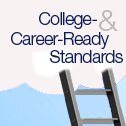Increasingly, states are allowing high schools to move away from traditional course seat-time requirements for graduation and allowing competency-based assessments, grade point average, class rank, and course rigor as measures to show students are ready for college.
A new report released Feb. 10 from the Denver-based Education Commission of the States reviewed how states are letting districts use some flexibility in how students demonstrate proficiency using multiple measures to gauge college readiness. The goal of these policies is to ease the transition from high school to college and get more students to pursue postsecondary education.

As of the 2014-15 school year, 47 states have established minimum high school graduation requirements, according to ECS. Of those, at least 18 states have complete or partial alignment between high school graduation course graduation requirements and statewide or systemwide college admission standards.
The report revealed a growing number of states offering competency-based assessments for students to show their mastery of content as an alternative to completing coursework. Some districts have added a requirement that students provide a portfolio of their work, such as writing samples, to reflect their learning.
ECS notes that some higher education institutions have responded by expanding admission requirements to recognize these alternative indicators.
“One of the important steps that needs to happen is for high school and higher education leaders and faculty to work more closely together to look at these multiple measures for demonstrating college readiness, to periodically review them, and understand which are more effective and clearly communicate their value to students, parents and campuses,” Mary Fulton, a policy analyst with the commission and a co-author of the report said in an interview. “There is encouraging activity at the state level, but there is some distance to go.”
The trend reflects some emerging research showing there are multiple factors that can predict success in college-level coursework, said Fulton. Once more of these policies are in place and it’s evident how well these measures play out in a student’s college career, she anticipates seeing more states expand how they recognize student achievement.
In some states, P-16 councils have been an effective way for K-12 and higher education to collaborate but Fulton said that there needs to be clearer pathways for these sectors to come together. As the common-core assessments roll out, high schools and colleges will need to discuss exam scores and come to some agreement about what performance level does indeed reflect college readiness, added Fulton.
Among the recommendations in the report, the commission encourages high schools to conduct early assessments in 11th grade to see if students are on track to be college ready and introduce interventions so they can get up to speed by graduation.
In a related Ed Week story, Liana Heitin recently wrote about how credit hours remain a vital measure, although 40 states now have policies that allow students to replace credit hours or Carnegie units with demonstrations of competency or out-of-school credit for academic credit. (See Credit Hours are Still Useful Measures for Schools.)
The latest report was part of the commission’s ongoing Blueprint for College Readiness project that included an analysis of state policy and searchable data portal launched last fall.